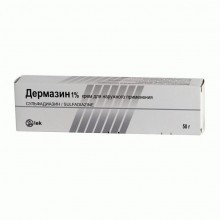



Dermazine - an antimicrobial drug for external use, sulfonamide.
When applied to the burn surface, silver sulfadiazine decomposes, slowly and continuously releasing silver ions and sulfanilamide ions, which inhibits the growth and reproduction of bacterial cells.
Dermazine has a broad spectrum of antibacterial activity, including:
- Virtually all types of microbes that cause infection of burns and other wounds on the surface of the skin, including:
- Pseudomonas aeruginosa.
- Escherichia coli.
- Proteus spp.
- Staphylococcus spp.
- Streptococcus spp.
- Klebsiella spp.
- Enterobacter spp.
Silver sulfadiazine penetrates necrotic tissue and exudate.
- Treatment and prevention of burn infections (including before autodermoplasty).
- Treatment and prevention of infection of trophic ulcers, wounds.
1 g of cream for external use of 1% contains:
- Active substances
- Sulfadiazin silver 10 mg.
- Excipients Cetyl alcohol, hydrogenated peanut oil, polysorbate 60, propylene glycol, methyl hydroxybenzoate, propyl hydroxy benzoate, purified water.
No customer reviews for the moment.
Dermazine can be applied with or without dressings. The drug is intended only for application to the skin.
After surgical treatment of the burn surface, the cream is applied on it in a layer of 2-4 mm thick. The drug should be applied 1-2 times / day.
Treatment should continue until the wound surface is completely healed.
The method of application of the cream is the same for the treatment of burns and trophic ulcers. Dressings should be changed daily.
Occasionally a local reaction is possible in the form of burning sensation and itching.
There are separate reports on the development of skin necrosis, erythema multiforme, skin pigmentation disorders, interstitial nephritis.
Individual cases of transient leukopenia in patients treated with silver sulfadiazine have been noted. Leukopenia with silver sulfadiazine is characterized mainly by a decrease in the number of neutrophils. The maximum decrease in the level of neutrophils is observed for 2-4 days after the start of treatment. Then their level is normalized within 2-4 days, while the continuation of silver sulfadiazine treatment does not affect the recovery of the number of leukocytes.
The degree of absorption of silver sulfadiazine depends on the size of the burn surface and the degree of tissue damage. In rare cases, any adverse reactions characteristic of sulfonamides may develop: impaired blood formation, including agranulocytosis, aplastic anemia, thrombocytopenia, and hemolytic anemia; skin allergies, including Stevens-Jones syndrome and exfoliative dermatitis; dyspeptic disorders, hepatitis and hepatocellular necrosis; reactions from the central nervous system and toxic nephrosis.
- Children's age up to 2 months.
- Premature newborns.
- Period of birth.
- Hypersensitivity to the drug.
- Hypersensitivity to sulfonamides.
Silver sulfadiazine can inactivate enzyme preparations for wound cleansing while they are being used simultaneously.
It is noted that with simultaneous use of cimetidine increases the risk of leukopenia.
Dermazine should not be used during pregnancy, except in cases where the potential use of life-saving use exceeds the potential harm to the fetus. The use of sulfonamides increases the risk of hyperbilirubinemia, so you should not appoint Dermazine especially in the third trimester of pregnancy and during childbirth. The exceptions are cases where the potential benefit for saving the patient's life exceeds the existing risk to the fetus.
It is not known whether silver sulfadiazine is excreted in human breast milk. However, other sulfonamides are found in milk. In addition, all sulfonamides increase the risk of hyperbilirubinemia. In connection with the possibility of serious side effects in an infant when sulfonamides are used in a nursing mother, if necessary, use of the drug during lactation should decide whether to stop breastfeeding, taking into account the degree of significance of treatment for the mother.
Precautions should be prescribed the drug to patients with hypersensitivity to sulfonamides because of the possibility of cross-sensitivity.
As with the use of other local antimicrobials, the development of superinfection is possible with silver sulfadiazine treatment.
Use with caution in patients with congenital insufficiency of glucose-6-phosphate dehydrogenase due to the risk of hemolysis.
When applying Dermazine on large-area burn wounds, serum sulfadiazine concentration can reach a therapeutic level when taken orally. In this case, it is necessary to control serum concentrations, control kidney function, as well as control the possible content of sulfadiazine in the urine.
With long-term use of Dermazine on a large surface of the skin should be monitored blood due to the possible development of leukopenia, thrombocytopenia or eosinophilia.
The drug should not be used for porphyria.
Do not let the cream in the eyes.
- Application for violations of the liver function To use the drug with caution in patients with liver dysfunction due to the possible accumulation of the drug due to delayed elimination. The question of whether to continue therapy should be addressed, given the possible consequences of its cancellation and the benefits of continuing. In case of continued treatment, serum sulfadiazine concentrations should be monitored.
- Use for disorders of the kidney With caution to appoint the drug to patients with impaired renal function due to the possible cumulation of the drug due to delayed elimination. The question of whether to continue therapy should be addressed, given the possible consequences of its cancellation and the benefits of continuing. In case of continued treatment, serum sulfadiazine concentrations should be monitored.
- Influence on the ability to drive vehicles and control mechanisms No influence Dermazine on the ability to drive vehicles and control mechanisms.
Argyria due to increased systemic absorption of silver does not develop.
- Symptoms: with prolonged use on a large surface of the body, serum sulfadiazine concentrations may approach the level achieved with systemic use, which increases the risk of adverse reactions characteristic of sulfonamides.
- Treatment: symptomatic therapy, determination of serum sulfanilamide concentration, abundant drinking (it is recommended to maintain daily diuresis at the level of 1200-1500 ml and more).